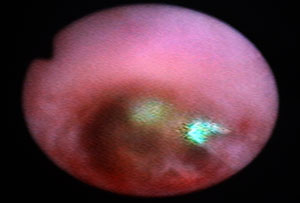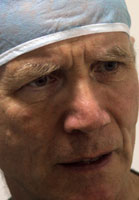It is said to be worse than childbirth – excruciating pain, leaving men and women in agony. Stones in the ureter or the kidney, make people disabled and doubled up in pain.
Not so long ago in the early 1980s the answer was going under the knife, leaving a huge cut across the tummy or sending shock waves to break-up the stone but this only for smaller and not-so-hard ones.
 |
| Dr. Wijeratne |
A major breakthrough in the minimally-invasive technique, however, came when British Consultant Urologist Dr. Graham Watson experimented with shattering stones using laser in the mid-1980s.
Laser is the optimum treatment in a situation where the person is in much pain or even otherwise to break the stones gently and in a controlled manner, the Sunday Times understands.
Recently, as the Sunday Times team watched, a young man with stones in his ureter walked into the newly-opened genito-urinary surgical unit at Durdans Hospital, underwent spinal anaesthesia, and looked on interestedly as Consultant Genito-Urinary Surgeon Dr. Srinath Chandrasekera, instead of wielding the scalpel took up the “scope”.
Inserting the scope through the urethra into the ureter and looking closely at the big-screen monitor with a clear view of the stone, the procedure began in the state-of-the-art theatre, with Dr. Chandrasekera pointing out that it is a “very big, hard stone of 1.2 cm X 1 cm” to the others on the team. The procedure would last about 20-30 minutes, with the patient leaving the hospital soon after.
Consultant Surgeons Dr. Ajith Malalasekera, Dr. Suren De Zilva and Dr. Anura Wijewardena also carry out the procedure at Durdans. So far 24 such procedures have been performed.
That day when the procedure using stone laser technology – believed to be a first in the Sri Lankan private health-care arena –was carried out was special because Dr. Watson himself was right there viewing how successful his brainchild, laser fragmentation of urinary calculi, is for which he has won much acclaim.
“Do you have a stone,” asks Dr. Watson with a smile, deftly and skilfully demonstrating the highly-sensitive and flexible ureteroscope (a telescope with a camera fixed to it) to us, explaining that commercial development of his idea took place rapidly in the 1980s because major advances were also underway in the telescope and camera systems.
It was a time when Western Europe was cutting open 100% of the cases of stone disease. Now it is 100% minimally-invasive, he stresses, adding that kidney stones are bad but stones in the ureter are worse, with many women who have had both children and stones opting to have a baby anytime but not a stone.Under this procedure, the ureteroscope is inserted through the urethra and once the stones are located and the surgeon sees them clearly on the monitor, laser rays are emitted to shatter the stones to sand along with a jet of water to wash them out.
 |
Delving into medical detail, Dr. Watson explains that the ureters are thin worm-like tubes and it may be better to use the laser technique with this delicate instrument for smaller stones. If, however, the stones are larger or in a location that is not easily accessible, there is another option to prevent causing stress to the ureters. In tropical countries, such stones tend to be more hard-baked because people sweat profusely and the urine is more concentrated.
This option is the percutaneous nephrolithotomy where the surgeon will make a small nick or incision in the back and tunnel or track into the kidney directly, after which the nephroscope is used to locate and remove the stone, he says.
Adds the Manager, Allied Medical Services of Durdans, Dr.Vibash Wijeratne: “It is minimally-invasive and painless. It is a day-care procedure and the patient is not confined to bed. He/she can leave the hospital and get back to work earlier than the conventional methods.”
Surgery cannot be done every time a patient develops stones, stresses Dr. Wijeratne, explaining that the laser procedure, however, can be carried out many times.
Dr. Watson paints the image of a cake, with the shockwave technique being the cake and the most cherished “icing” being the laser technique coupled with the percutaneous nephrolithotomy.
Stones as ancient as the mummies
Stones, however, are not an affliction of the modern world. An Egyptian mummy dating back to 7,000 B.C. suffered from stones but unfortunately didn’t have access to modern medicine to get them removed. So to death, the mummy carried the stones and was relieved of them only recently through percutaneous nephrolithotomy.
The stones were displayed at the Hunterian Museum in England but ironically “shattered” by a German bomber during World War II, adds Dr. Watson.
Make laser treatment available
in state sector: Dr. Watson
Stones in the kidneys or ureters are common and about 10% of the population develops them. Some have stones throughout life and others develop them every few years, it is learnt.
 |
| Dr. Watson |
There is much pain and if neglected such stones can lead to kidney disease, points out Dr. Watson, urging that Sri Lanka should make stone laser treatment available in the state sector as well.
“Think of the advantages,” says this pioneering surgeon. “It is cheaper for the patient unlike surgery because he/she has to take fewer days off work, especially as it affects a lot of poor people. After surgery, such patients can’t do physical work for several weeks, but not after this procedure.”
Stone disease affects affluent people and those living in hot countries, with some families genetically more prone than others, says Dr. Watson, explaining that eating well and not drinking enough water could lead to stones.
Those who work or exercise strenuously should make sure that they drink a lot of water. Diabetics are also prone to stones.The urine should not be too dark, it should be the colour of champagne, he says. |




